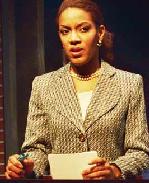SITE GUIDE
SEARCH
REVIEWS
FEATURES
NEWS
Etcetera and
Short Term Listings
LISTINGS
Broadway
Off-Broadway
NYC Restaurants
BOOKS and CDs
OTHER PLACES
Berkshires
London
California
New Jersey
DC
Philadelphia
Elsewhere
QUOTES
TKTS
PLAYWRIGHTS' ALBUMS
LETTERS TO EDITOR
FILM
LINKS
MISCELLANEOUS
Free Updates
Masthead
Writing for Us
A CurtainUp Review
A House With No Walls
|
{In a house with no walls} they can come right through and do whatever they
please with us.— Ona Judge
|

Tracey Conyer Lee (as Cadence Lane) In A House With No Walls
(Photo: Seth Rozin) |
Its inspiration was the uproar in Philadelphia that began in 2002 over the impending construction of the new Liberty Bell Center on the site of slave quarters once attached to George Washington’s long vanished presidential mansion. At the crux of this formal, ordered argument is the clash of two ways of thinking. The playwright posits a Black conservative point of view into a version of the real-life confrontation in which historians and representatives of the African-American community were pitted against the National Park Service.
The set, which evokes old red brick Philadelphia, is by Peter Whinnery, who designed sets for five Gibbons premieres. The small slave house site, cause of the controversy, is staked out on stage with posts and rope and occupied by two of its eight resident slaves. Historical figures Ona Judge, a faithful servant of Martha Washington, and her brother Austin, who longs to go to sea, inhabit a story plane set in the past and vicariously visible in the present.
Salif Camara (Johnnie Hobbs, Jr.), a liberal activist reminiscent of heroic Blacks in the sixties, is an artist with the soap box and microphone. He demands a re-creation of the tiny slave quarters discovered on the Washington property site. Cadence Lane (Tracey Conyer Lee), a successful Black woman, panel member for the new museum, and Condi Rice figure, sees any memorial of the slave site as a "shrine to white oppression and Black helplessness."
Adherents of the two conflicting positions present their cases with passion and persuasiveness. They are offset by two other points of view, furnished by Allen Rosen (Seth Reichgott), a low-profile history professor, and Steven Gardner (Tim Moyer), a retired Republican Congressman and highly placed museum official who’s allied with the National Park Service.
Playwright Gibbons lets the arrows fly where they may. Neither angels nor devils, the protagonists sometimes look good and sometimes less so. Co-existing with truth and zeal on both sides is evidence of self-promotion. Salif believes he is being true to his heritage by battling to enshrine the memory of what slaves endured. Should museums suppress things that are ugly? Cadence claims her opponent, who is merely seeking "cultural ammunition," is setting back African American progress. A "public intellectual," she is not Black enough for him: "Where have you been, sister? We’ve been choosing freedom since the first day we were brought to this country." She counters that he and his adherents " want to be outraged. Outrage is their life blood." It is time to move on.
Cadence fears that many young black people view education as a white value to be rejected. She is fighting images of victimhood which "define us to the world." Her position aligns with Bill Cosby’s infamous 2004 "Pound Cake" speech: "Now look, I’m telling you. It’s not what they’re doing to us. It’s what we’re not doing. 50 percent drop out. . . These people are fighting hard to be ignorant."
The Cadence-Salif relationship is complemented by the minor motif of the Cadence-Rosen relationship. They go back. She changed and he didn’t. Rosen, a moderate liberal, who seems to represent the playwright or the audience, is challenged by Cadence to take a bold and unpopular stand.
Buried at the heart of the play is the important Cadence-Ona connection with its emotional and political dimensions. The modern, emancipated woman is an implied spiritual descendant of Ona, the brave slave woman, who made a leap from bondage to enlightenment when she escaped to freedom.
The actors are all very good. Particularly notable are Johnnie Hobbs, Jr as Salif and Bowman Wright as slave Austin Judge. Austin is a difficult role for a Black man to pull off these days, but he does it. Conyer Lee as Cadence is shiny, and Lavita Shaurice is a sympathetic and engaging Ona. Seth Reichgott navigates the little minefield of playing Allen Rosen. Finally, Tim Moyer, in a number of roles, is sturdy and also surprising.
Director Seth Rozin deftly manages the complicated space and time elements. Time layers coexist and there are crossovers. For example, Rosen, a costumed guide, participates in the past. As Quaker activist Tobias Humphries he explains to the slaves how President Washington, who had held out the promise of freedom, has actively taken steps to ensure their continuing slave status. Ona says that in a house with no walls, "they can come right through and do whatever they please with us." In the present a compromise is proposed for the museum-- an outline house with no walls, reminiscent of architect Venturi’s 1976 Franklin Court.
This play, neither a comedy nor a tragedy, takes its place in the long tradition of polemical and didactic theater. Although actors embody positions, their characters are well drawn, believable sketches of real persons. There is even a bit of romance.
A good faith work, A House With No Walls doesn’t set up straw men, but lays out real arguments and airs issues, popular or not, in a dialectic about decisions facing Black people. It’s fascinating that these salvos come from one man, Gibbons, who counters each argument he devises. One can almost imagine his solitaire chess game and his schizophrenic conversations with himself as he wrought this play. Intended not only for the predominantly white liberal audience that supports InterAct and other theaters with a social mission, this is a fine play for African Americans and everyone to see and ponder. To commandeer a "bad" word from the play itself, it is a balanced argument. This is good medicine, enjoyable and well worthwhile.
Editor's Note: Here are links to CurtainUp reviews of the other plays mentioned above:
Bee-luther-hatchee-Off-Broadway
Permanent Collection-Los Angeles
Permanent Collection-DC
|
A HOUSE WITH NO WALLS
by Thomas Gibbons Directed by Seth Rozin Cast: Tracey Conyer Lee, Johnnie Hobbs, Jr., Tim Moyer, Seth Reichgott, Lavita Shaurice, Bowman Wright Set and Lighting Design: Peter Whinnery Sound Design: Kevin Francis Costume Design: Andre Harrington 01/19/07- 02/18/07, Opening 01/24/07 2 hours, 10 mins with one 15 min intermission Reviewed by Kathryn Osenlund based on 01/25/07 performance at the Adrienne Theater, Sansom Street. |

Easy-on-the budget super gift for yourself and your musical loving friends. Tons of gorgeous pictures.

Leonard Maltin's 2007 Movie Guide

At This Theater
Leonard Maltin's 2005 Movie Guide

 >
>

